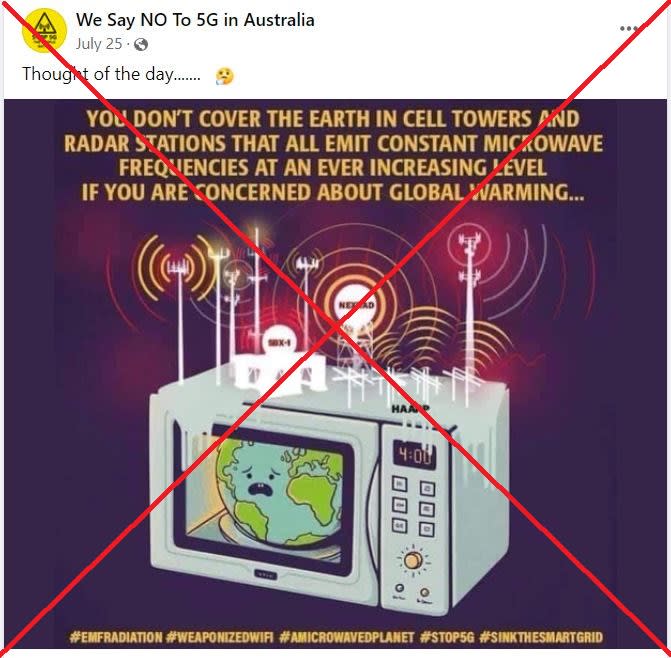Multiple posts shared hundreds of times worldwide claim that microwave frequencies emitted by 5G cell towers and radar stations are significant contributors to global warming. However, experts told AFP that although the infrastructure needed to support 5G networks may marginally contribute to global warming, there is no evidence that microwave frequencies from 5G cell towers contribute to climate change. According to the United Nations, fossil fuels are by far the largest contributor to global climate change, accounting for more than 75 percent of global greenhouse emissions.
“You don’t cover the Earth in cell towers and radar stations that all emit constant microwave frequencies at an ever-increasing level if you are concerned about global warming…” reads the text in an image shared on Facebook here on July 25, 2022.
It was shared in a Facebook group called “We Say NO To 5G in Australia”, which has more than 19,000 followers.
The image shows the Earth inside a microwave that has cell towers and radar stations protruding from the top.
The labels “SBX-1“, “NEXRAD” and “HAARP” can be seen on some of the protrusions, and refer to the various types of radar used by the United States.
The hashtags “#EMFRadiation #WeaponizedWiFi #AMicrowavedPlanet #Stop5G #SinkTheSmartGrid” are also included at the bottom of the picture.


Screenshot of the misleading Facebook post, captured on August 29, 2022.
The same image was also shared alongside a similar claim by users in Australia and the United States, as well as by other anti-5G groups in New Zealand and Denmark.
However, the claim is misleading, according to experts.
Global warming claim
Dr Sarah Loughran, director of radiation research and advice at the Australian Radiation Protection and Nuclear Safety Agency (ARPANSA), told AFP: “There is no evidence that radio waves, microwave frequencies, or 5G technologies, are linked to or contribute to global warming in any way”.
She went on to say that it is also false to claim “cell towers are emitting constant microwave frequencies at an increasing level”.
“Cell towers use radio waves to connect mobile devices and emissions must comply with exposure limits set in the Australian Safety Standard,” she said.
Fossil fuels — coal, oil and gas — remain the largest contributor to global climate change, accounting for more than 75 percent of global greenhouse gas emissions, according to the United Nations.
Other contributors include power generation, good manufacturing, forest destruction, use of transportation, food production, buildings energy use and overconsumption, according to the UN.
By contrast, the telecommunications industry contributes around 1.4 percent as outlined by experts in this report by Stockholm-based telecommunications company Ericsson.
Dr Diep Nguyen, a senior lecturer at the University of Technology Sydney, told AFP that linking 5G technology to global warming is “too extreme” because every action that requires energy can contribute to climate change.
He said 5G technology is more energy-efficient than 4G or 3G networks.
“5G does consume more power than 4G in terms of the totality, but for the energy per data unit, 5G is much more energy efficient than 4G and others,” he said.
Not harmful to humans
Experts have previously told AFP there is no evidence that 5G is harmful to the human body and dismissed false claims that it created the novel coronavirus.
“There are not any adverse health effects caused by exposure to 5G,” Rodney Croft, a professor at the University of Wollongong, told AFP.
“‘Radiation’ refers to both ionizing and non-ionizing radiation, and although ionizing radiation (such as from X-rays or nuclear reactions) can cause serious health effects such as cancer, non-ionizing radiation at the levels related to 5G cannot cause any health effects,” he said.
According to the Australian Radiation Protection and Nuclear Safety Agency (ARPANSA), cell phone towers in Australia emit low-level radiofrequency (RF) electromagnetic energy (EME) that does not affect human health.
“No adverse health effects are expected from continuous exposure to the RF EME emitted by the antennas on mobile phone base stations,” it says.




